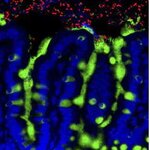Immunology

People treated in hospitals and other health care settings are increasingly at risk of infection with multidrug-resistant bacteria. Many of these microbes produce enzymes called extended-spectrum β-lactamases (ESBLs), which make them resistant to antibiotics. Understanding how ESBL bacteria spread from person to person is key to developing effective prevention strategies.
An observational study conducted in a French hospital showed that human contact was responsible for 90 percent of the spread of one species of antibiotic-resistant bacteria to new patients, but less than 60 percent of the…

Raw milk sold by Miller’s Biodiversity Farm in Quarryville, Pennsylvania and laced with Brucella strain RB51 has been linked to exposures in 19 states by the U.S. Centers for Disease Control and Prevention.
Raw milk, a recent trend by organic food lovers, lacks pasteurization, a process created by Louis Pasteur that has saved millions of lives by removing harmful bacteria like RB51. A cow that tested positive for RB51 has been removed from the milking herd and after one case of infection was confirmed in New York in November 2018, there are concerns that an unknown number of…

Like " I had insomnia last night" and "I am so OCD", medical terms often become colloquial. So it is with people who say they had a "stomach flu."
There are stomach virusus, but what many people commonly call “stomach flu” isn’t flu at all. "Flu" is short for influenza, and that is respiratory so it involves lungs, not the stomach. What people call a stomach flu is instead viral gastroenteritis. It could be rotavirus, norovirus, adenovirus or something else, and could have been through tainted food.
In a Mayo Clinic video, internist Cindy A. Kermott, M.D. explains the difference and…

One to two percent of people have celiac disease, and the first thing they will tell you is that it is not a fad diet, no matter how many books or Dr. Oz segments tout gluten-free. To celiac patients, it is like poison and the replacements for gluten often contain extra sugar, extra fat, hydroxypropyl methyl cellulose and xanthan gum.
Science may soon be able to help. Gluten is a mixture of glutenin and gliadin proteins, which build a network that gives wheat bread itsproperties and quality. Most gliadins and part of the glutenins contain immunogenic epitopes, which are the actual trigger of…

When a sneeze happens, around 100,000 contagious germs for things like the common cold, influenza and tuberculosis move through the air at speeds of up to 100 miles per hour.
It sounds scary, but there are numerous environmental factors that impact the actual transmission of disease, and a new study sought to determine those right down to the level of a single aerosol particle and a single bacterium.
What factors impact how well those aerosol droplets transport pathogens? Along with obvious things like covering your mouth and nose, relative humidity, temperature,…

In the past 30 years, food allergies have become increasingly common in the United States. Changes to human genetics can’t explain the sudden rise. That is because it takes many generations for changes to spread that widely within a population. Perhaps the explanation lies in changes to our environment, particularly our internal environment.
Shifting lifestyle practices over the last half-century – increasing antibiotic and antimicrobial use, surface sterilization, air filtration and changes to diet – have changed our internal environment and wiped out important bacteria with beneficial…

Some indigenous peoples wear body paint, and most most of the indigenous communities who paint their bodies live in areas where there is an abundance of bloodsucking horseflies, mosquitoes or tsetse flies.
Where insects bite people there is a risk of bacteria, parasites and other pathogens being transferred. More insects, more risk. Did paint come into popularity for protection it might offer? A new study set out to find if the two were linked, and not just cultural decoration.
“Body-painting began long before humans started to wear clothes. There are archaeological finds that…

If mouse studies were transferable to humans, we'd have cured every disease thousands of times. That is the big reason why you shouldn't accept scaremongering about the chemical of the week in the New York Times, or claims about Miracle Vegetables in the Washington Post.
Stem cell therapy is all the rage, with suspect companies sprouting up like supplement stores, claiming to be a benefit for this and that. Often all they have are mouse studies and FDA disclaimers on their side. That's not to say mouse studies are not valuable, they eliminate a lot of bad products, and in some instances mouse…

As anti-smoking groups like the American Council on Science and Health have long contended, while nicotine may be addictive, so are lots of things, from video games to coffee. It's the toxins in cigarette smoke that will kill you.
For that reason, public-health oriented anti-smoking groups have embraced nicotine vaping devices ("e-cigarettes") as one tool in the tool chest of harm reduction and (preferably) smoking cessation. Yet some smoking groups, and even the U.S. Centers for Disease Control and Prevention, have migrated from being a war on cigarettes to being in war on some tobacco…

In a 2015 analysis, antibiotic resistance continued to increase for most bacteria and antibiotics under surveillance. It is worrying to see increased resistance to last-line antibiotics, but we still have time to turn the tide and ensure that antibiotics remain effective.
In particular, the EU average percentage of carbapenem resistance in Klebsiella pneumoniae increased from 6.2% in 2012 to 8.1% in 2015, and combined resistance to carbapenems and polymyxins (e.g. colistin) was sometimes reported. These two groups of antibiotics are considered last-line antibiotics as they usually are the…